The Pixel 6 Pro is the best phone Google has ever made, including every feature you’d want in a flagship 2021 device. The PIxel 6 Pro showcases strong performance, some great software additions, a unique design and an excellent camera system.
And it does that while still undercutting its rivals by price. The 6.7-inch base 128GB model costs $899 (£849, AU$1,299), a sizable chunk less than the 6.1-inch iPhone 13 Pro’s $999 price and even more off the $1,099 Apple wants for the larger 6.7-inch iPhone 13 Pro Max.
Like
- Excellent cameras
- Solid all-round performance
- Neat Android 12 interface
- Attractive design
Don’t Like
- Battery is good, but not great
- Fast charge isn’t all that fast
- No face unlock
While last year’s Pixel 5 was best seen as a midrange phone with some higher-end touches, the Pixel 6 Pro is premium all the way. From its glass and metal design, to its high-resolution display and its superb triple camera, there’s a lot to like here. Then there’s the Tensor processor — a chip custom-made by Google for the phone — which provides ample power for all of your daily needs, better security features, 5G connectivity and a slick Android 12 interface. Battery life is good — certainly above average — but not great, with the iPhone 13 Pro putting in a stronger performance.
Google’s Pixel 6 Pro feels every bit as premium as it looks
Its best Android rival is the Samsung Galaxy S21 Ultra which does have some neat camera additions (that 10x zoom, for one thing) but it costs more and the Pixel 6 Pro offers a more user-friendly experience. The iPhone 13 Pro and Pro Max offer superb all-round use, but come at a higher price and if you’re already entrenched in the Android ecosystem, it’s likely not worth switching and buying all those apps again.
Those looking for the best all-round Android experience should absolutely look towards the Pixel 6 Pro.
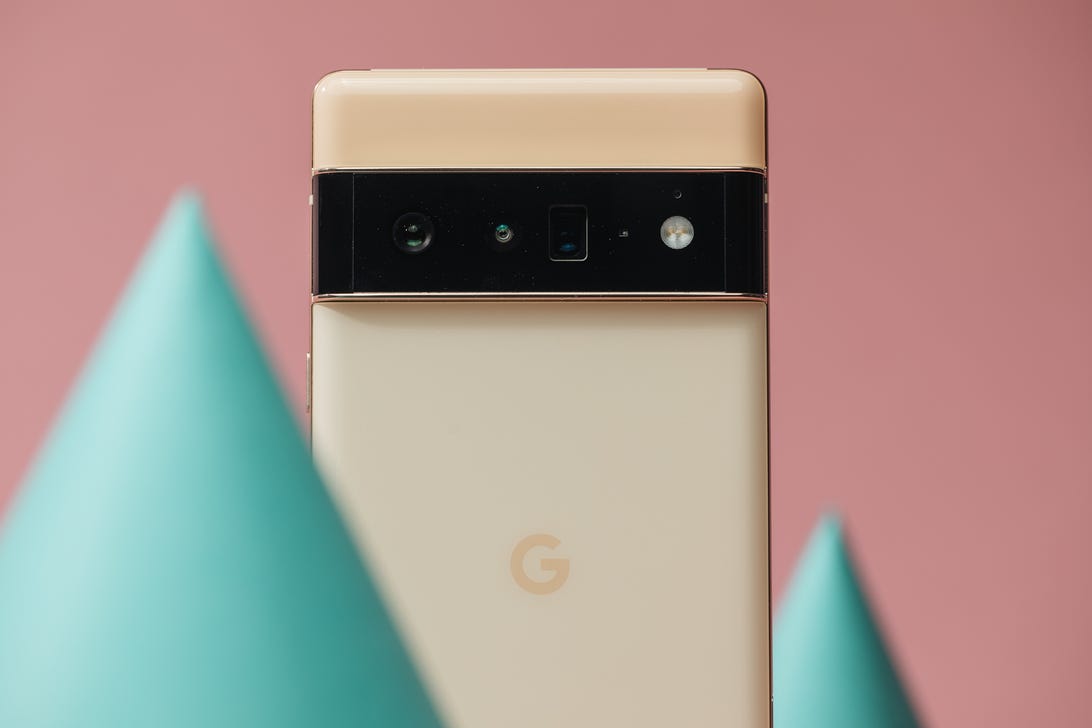
Andrew Hoyle/CNET
Pixel 6 Pro or Pixel 6?
The stepdown $599 (£599, AU$999) Pixel 6 packs the same Tensor processor and lovely Android 12 software for $300 less than the Pro, but there are a few compromises it makes in order to come to that cheaper price.
It has a smaller and lower resolution 6.4-inch display that lacks the curving finesse of the Pro. Its battery is smaller, it has 8GB rather than 12GB of RAM and it lacks the 4x telephoto zoom lens found on the Pro.

The Pixel 6 Pro has a 6.7-inch display while the Pixel 6’s measures 6.4 inches.
Andrew Hoyle/CNET
But it’s still a great phone that’s well worth considering. It provides many of the same perks of the Pixel 6 Pro at a much lower price, especially if you don’t care about the top-end performance offered by the flagship. As my colleague Patrick Holland put it in his review of the phone, “For the price, I can’t think of a better phone to recommend right now.”
A fresh design that stands out
I didn’t love the look of last year’s Pixel 5. The matte, rubberized back gave the phone a more budget feel than its $699 price tag suggested. The Pixel 6 Pro is worlds apart. The rear is all glass — toughened Gorilla Glass Victus, in fact — that curves at the edges to meet the 100% recycled aluminum frame.
The glass curves at the edges on the front, too, as does the display beneath it, making it not only look more premium, but feel like a truly flagship device when you hold it in your hand. It’s big though, packing in a 6.7-inch display, which will make it more cumbersome for some than the 6-inch Pixel 5 or 6.4-inch Pixel 6. That glass makes it slippery, too, so consider one of Google’s protective cases if you’re nervous about dropping it.

The Pixel 6 Pro, flanked by the iPhone 13 Pro (left) and Pixel 5.
Andrew Hoyle/CNET
It is IP68-rated for water resistance, meaning it can withstand being in 1 meter (about 3 feet) of water for up to 30 minutes. No, that doesn’t mean you can take it swimming, but it does mean it should be able to shake off having the odd beer spilled over it by your clumsy mates.
An interesting design choice is the large camera bar that stretches across the back. It protrudes from the phone by about 3mm, so it doesn’t lie totally flat when you put it on a table, but nor does it rock from corner to corner like phones with camera bumps just on one side (like the S21 Ultra). I like the look of the phone and it certainly stands out. One tip though: Get the Sorta Sunny orangey-peachy color, if you can find it in stock. The black-and-gray option, Stormy Black, looks rather dull by comparison.
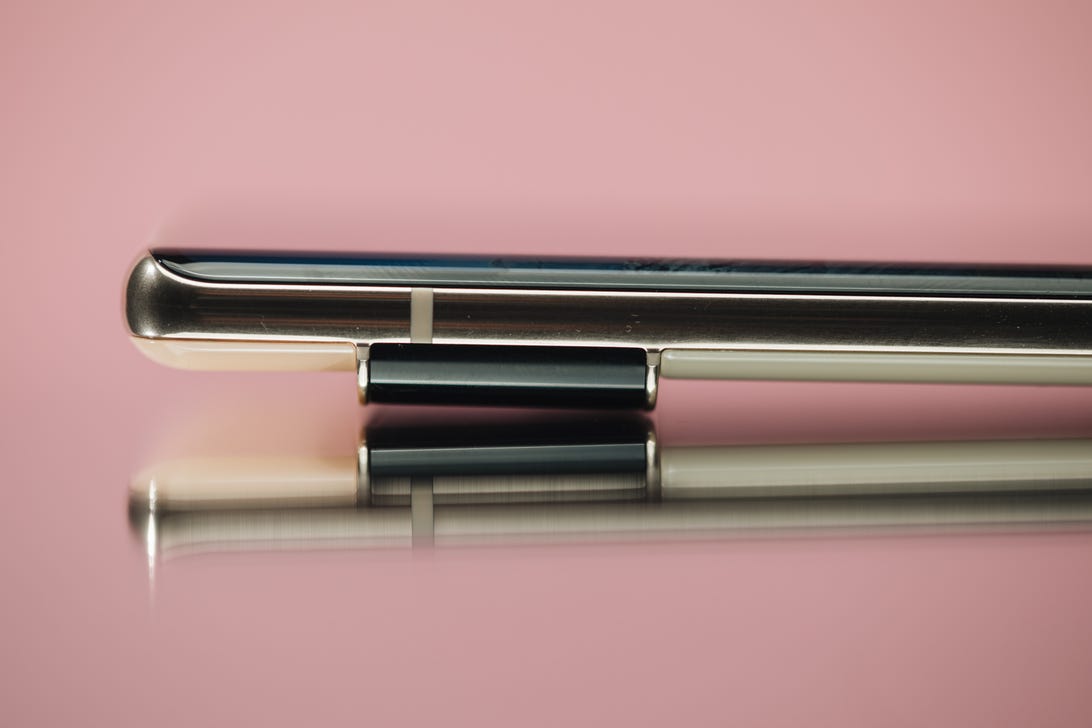
The camera strip protrudes from the phone by about 3mm. As a result, it won’t lie flat on a table.
Andrew Hoyle/CNET
The rear-mounted fingerprint scanner seen on the Pixel 5 has been removed, replaced instead with an in-screen scanner, which I found worked accurately and quickly most of the time, although Patrick found the Pixel 6’s scanner to be much more hit and miss in his review. There’s no face unlock ability, which is a bit of a shame, but with masks still being a requirement in many indoor areas due to COVID-19, having a fingerprint scanner is arguably more useful anyway.
Three excellent cameras
That big bar on the back hides three cameras: a 12-megapixel ultrawide; a 48-megapixel telephoto that offers 4x optical zoom; and a main camera that uses a larger 1/1.3-inch sensor, which Google says captures 2.5x more light than the Pixel 5. The cameras on the Pixel phones have always been excellent, and this new generation is no different.
Images from the main camera lens are stunning. They’re vibrant, they’re packed with detail and there’s an amazing balance of exposure, with bright skies kept under control and shadowy areas being easily visible.

Pixel 6 Pro, main camera.
Andrew Hoyle/CNET
The golden colors of the leaves have been captured beautifully here, with a rich blue sky visible behind.

iPhone 13 Pro, main camera.
Andrew Hoyle/CNET
And here’s the same image taken on the iPhone 13 Pro. There’s little to choose between them, but if I was being hypercritical, I’d say that the white balance on the Pixel 6 Pro has resulted in a warmer, more orange tone on the tree trunk, which I think looks better. You can see how the Pixel 6 Pro’s camera really stacks up against the iPhone 13 Pro’s in my photography shootout.
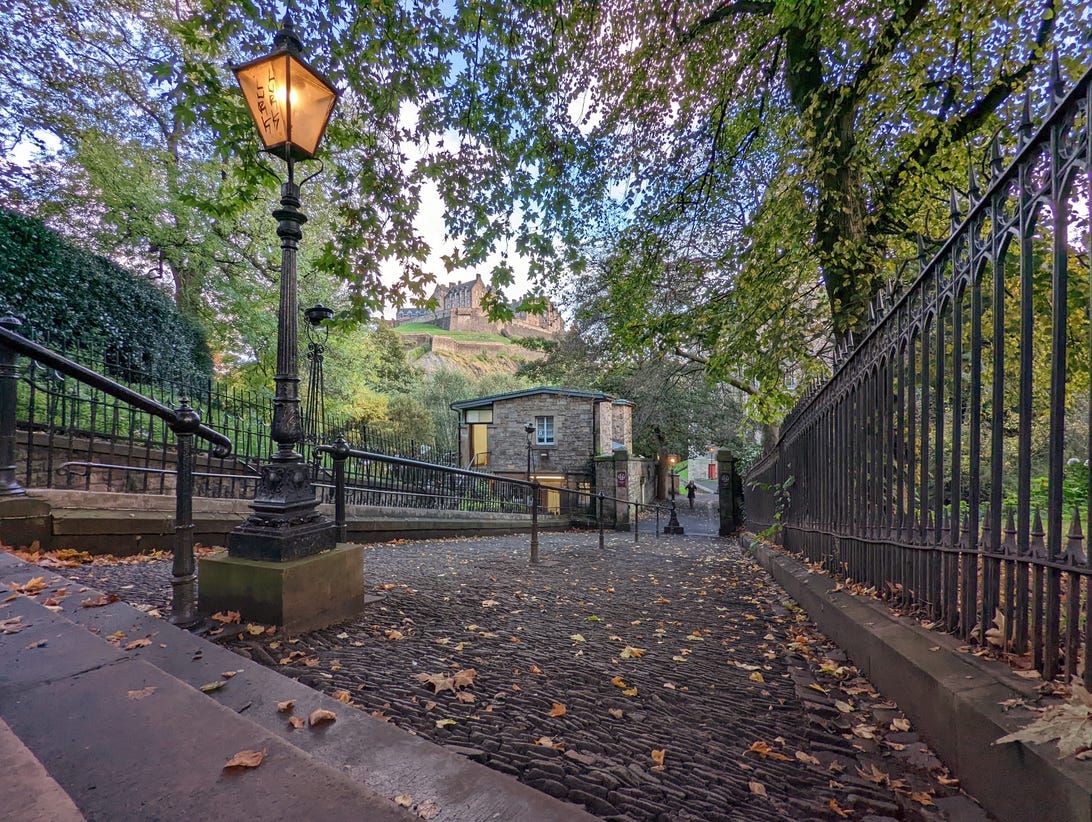
Pixel 6 Pro, main camera.
Andrew Hoyle/CNET
This scene looking towards the beautiful Edinburgh castle is a challenging shot, with dark shadows and an extremely bright sky beyond the trees. The Pixel 6 Pro has handled it well though, maintaining a lovely exposure overall.

Pixel 6 Pro, main camera.
Andrew Hoyle/CNET
And it’s much the same here, with vivid blue skies, superb exposure and plenty of detail.

Pixel 6 Pro, ultrawide camera.
Andrew Hoyle/CNET
Switching to the ultrawide lens, the scene maintains the rich colors and exposure. Zoom closer in and it’s clear it has less overall detail, but it’s still a lovely shot.
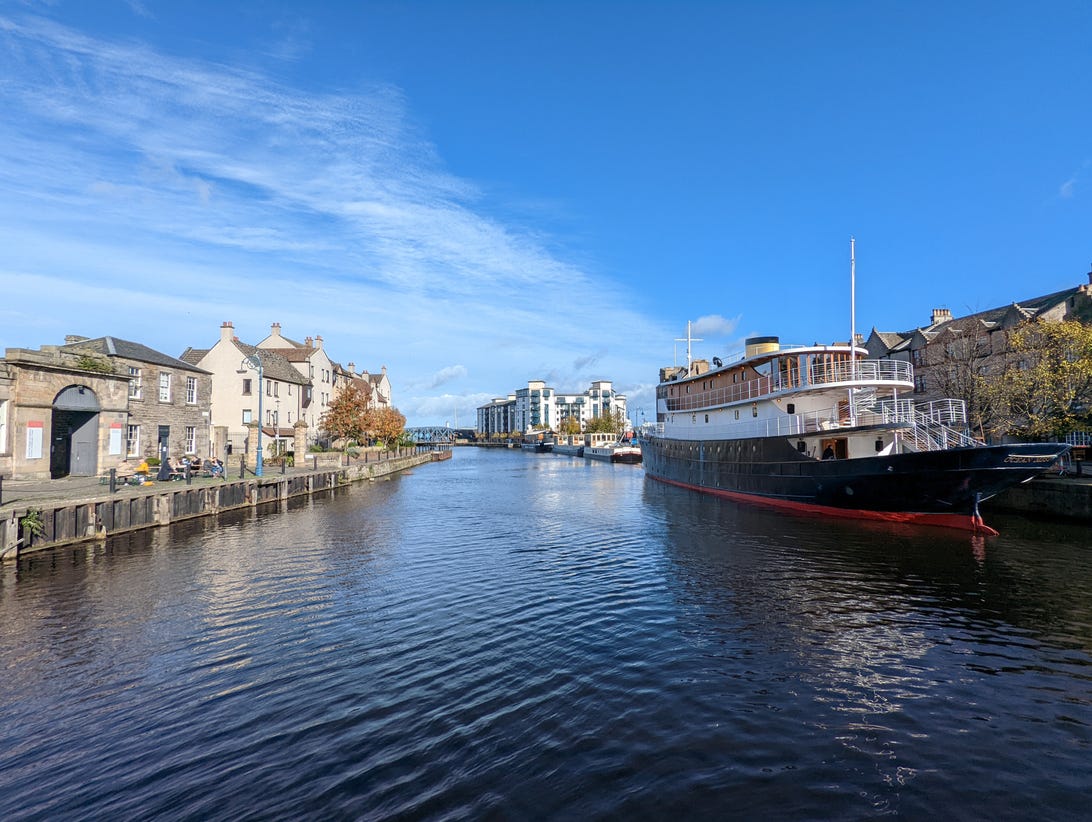
Pixel 6 Pro, ultrawide camera.
Andrew Hoyle/CNET
Another from the Pixel 6 Pro’s ultrawide lens. But check out the iPhone 13 Pro’s:

iPhone 13 Pro, ultrawide lens.
Andrew Hoyle/CNET
The iPhone’s offers a much wider view that lets you capture more in the scene. They’re both excellent wide lenses and both do a great job in packing in those beautiful colors, but I’d like to have seen the Pixel offering a slightly wider scene.
The 4x zoom lens is amazing too, providing tons of detail thanks to its high resolution sensor. I think 4x is a great zoom level for a phone as well; it allows you to find compositions that would be beyond the reach of lesser zoom levels, but it’s not quite as restrictive as the 10x zoom you’ll find on the Galaxy S21. It’s a zoom level I feel I’d use a lot on my travels and have already taken a few 4x shots with the phone that I’m really pleased with as artistic images.

Pixel 6 Pro, 4x zoom.
Andrew Hoyle/CNET
This zoomed-in image is so pin-sharp I can actually read the headline on the newspaper. It’s a really impressive lens that doesn’t force you to make any kind of compromise on quality in order to achieve those zoom levels. By comparison, the iPhone 13 Pro’s optical zoom maxes out at 3x, so the Pixel 6 Pro is able to achieve a closer-up image. Which, frankly, I’d take any day over a wider-angle view.

Pixel 6 Pro, 4x zoom.
Andrew Hoyle/CNET
It’s handy as well for focusing your view on a smaller scene like this, capturing intimate little still-life scenes, rather than grand, sweeping vistas. The fine textures on the leaves here are extremely sharp.
Google has thrown some extra features in too, including a tool that automatically removes people from the background in an image, which sometimes works well, and sometimes leaves a big splotch where a person once stood. Then there’s the long exposure mode, which allows you to create ethereal blurred waterscapes and the Nightscape mode, which does an excellent job of taking shots in the dark.
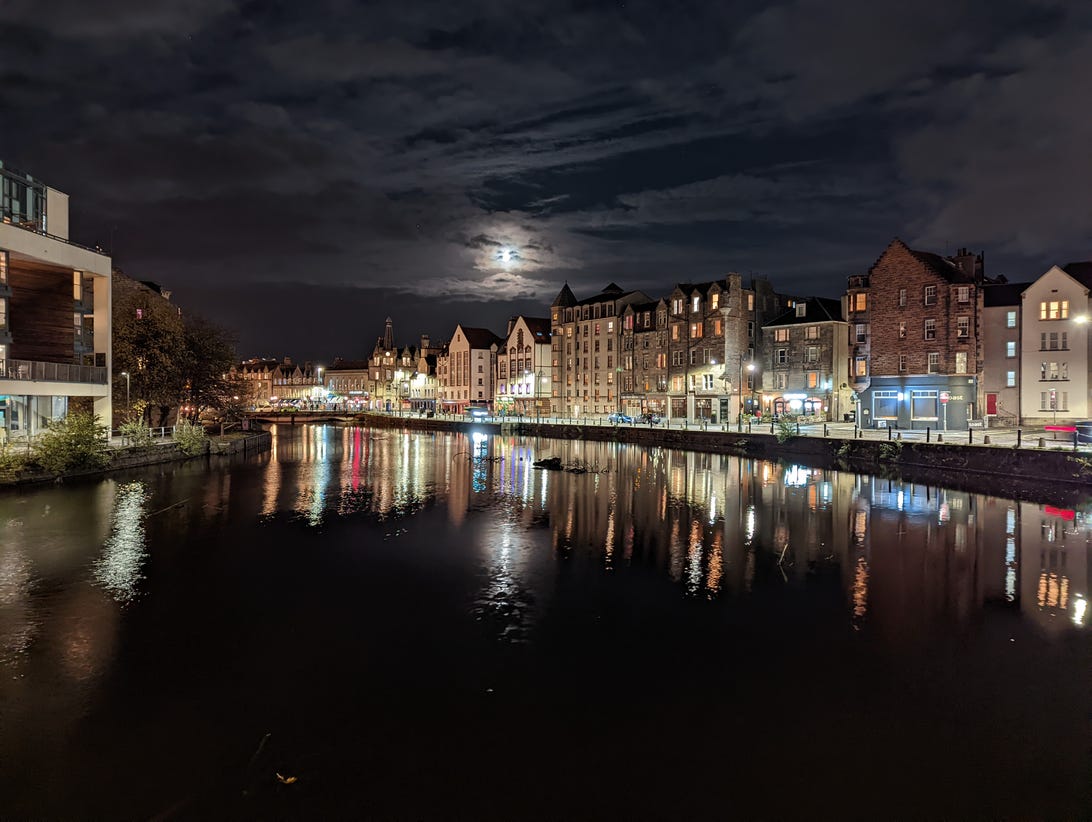
Pixel 6 pro, Nightscape photo.
Andrew Hoyle/CNET
I’m seriously impressed with the photography abilities of the Pixel 6 Pro and there’s no question that it’s among the best cameras you can get on a phone right now. Video quality is excellent as well, with superb dynamic range, excellent image stabilization and plenty of detail thanks to the 4K resolution.
Does Google’s Tensor processor make a difference?
At the heart of the phone is Google’s first home-baked processor, named Tensor. It’s a significant move for Google to produce its own silicon and it shows a strong commitment to remain in the hardware game — after all, you don’t go to the effort of developing your own processors as a one-off experiment.
But it’s essentially irrelevant once you get the Pixel in your hand, as it functions just like any other phone. It’s nippy to navigate around the Android 12 interface, games like Asphalt 9: Legends and Call of Duty play perfectly, while photo editing and video streaming…
Pixel 6 Pro review: Google’s flagship phone is a proper iPhone rival
